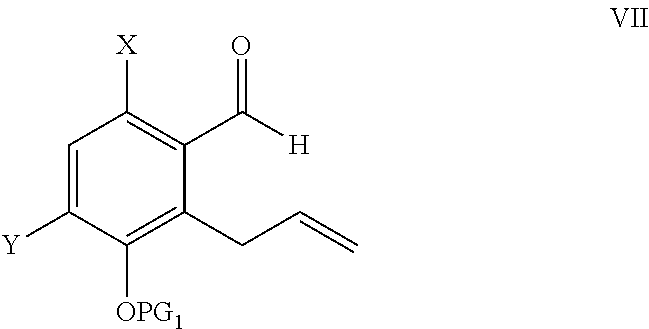Process for the preparation of treprostinil and derivatives thereof
a technology of treprostin and derivatives, which is applied in the preparation of carboxylic compounds, bulk chemical production, organic chemistry, etc., to achieve the effect of increasing regioselectivity
- Summary
- Abstract
- Description
- Claims
- Application Information
AI Technical Summary
Benefits of technology
Problems solved by technology
Method used
Image
Examples
example 1
Preparation of Bromobenzaldehyde 2
[0083]
[0084]Compound 2 is prepared as described in Bioorganic & Medicinal Chemistry Letters, 20(3), 1169-1172; 2010 or according to Journal of Organic Chemistry, 67(26), 9248-9256; 2002.
example 2
Preparation of Allylether 3
[0085]
[0086]To a dry 5 L three necked round bottom flask fitted with a condensor, temperature port, and stirrer, was added 6-bromo-meta hydroxyl benzaldehyde (2, 250 g, 1.23 moles) in dimethyl formamide (1250 mL). To the resulting solution was added anhydrous pottasium carbonate (538 g, 3.81 moles) under stirring. To this mixture was added slowly allyl bromide and reaction mixture maintained under stirring until the reaction was complete (monitored by thin layer chromatography (TLC) in hexane:dichlor-methane:ethyl acetate::7:4:0.5). After reaction completion dichloromethane and water were added and resulting solution stirred and layer separation carried out. The organic layer treated with 10% NaOH solution and layer separation repeated. The organic layer obtained was distilled out under reduced pressure to obtain 6-bromo-3-allyloxy benzaldehyde as a brownish liquid mass; yield 290 g (98%), purity by HPLC>95%. 1HNMR (CDCl3): 4.55-4.65 (s, 2H), 5.15-5.40 (m,...
example 3
Claisen Rearrangement to Allyl-Benzaldehydes 4a and 4b (WO0176693)
[0087]
[0088]To a 50 L glass flask assemby was added allyl ether (3, 600 g, 2.48 moles) in o-dichlorobenzne (18 L). The resulting solution was heated slowly up to 155° C. in an oil bath and left at temperature for 40 h. The reaction mass was cooled and extracted with 10% NaOH solution. The organic layer of o-dichlorobenzene was taken back into the glass flask assembly and the heating operation was repeated twice. The aqueous layer was treated with HCl and extracted into dichloromethane. The dichoromethane layer was part distilled and hexane added to the flask. This solution was left to stand over a period of 1-2 days under cooling and then filtered using a Bucchner funnel, and the cake was washed with chilled hexane to give 6-bromo-3-hydroxy-2-allyl benzaldehyde as dark brown to blackish colored powder; total yield 160 g (27%), purity by HPLC>93%.
PUM
| Property | Measurement | Unit |
|---|---|---|
| temperature | aaaaa | aaaaa |
| temperature | aaaaa | aaaaa |
| temperature | aaaaa | aaaaa |
Abstract
Description
Claims
Application Information
 Login to View More
Login to View More - R&D
- Intellectual Property
- Life Sciences
- Materials
- Tech Scout
- Unparalleled Data Quality
- Higher Quality Content
- 60% Fewer Hallucinations
Browse by: Latest US Patents, China's latest patents, Technical Efficacy Thesaurus, Application Domain, Technology Topic, Popular Technical Reports.
© 2025 PatSnap. All rights reserved.Legal|Privacy policy|Modern Slavery Act Transparency Statement|Sitemap|About US| Contact US: help@patsnap.com



